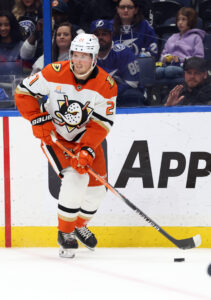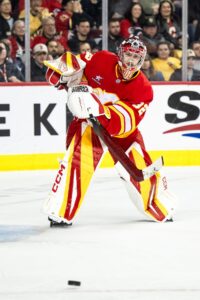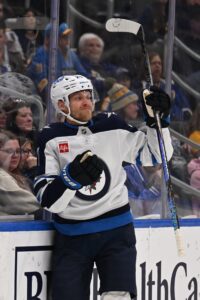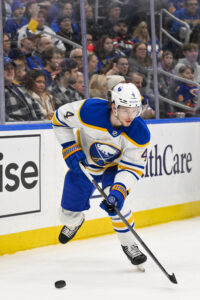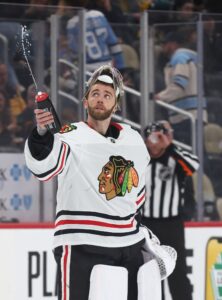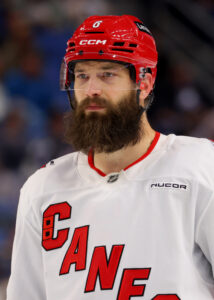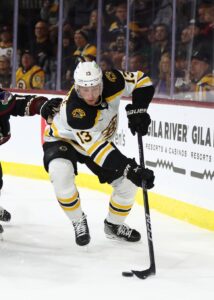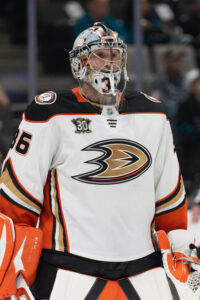With the regular season now upon us, the bulk of the heavy lifting has been done from a roster perspective. Most unrestricted free agents have found new homes, the arbitration period has come and gone, and the trade market has cooled. Accordingly, it’s a good time to take a look at what each team accomplished over the offseason. Next up is a look at the Anaheim Ducks.
The Ducks have been rebuilding for several years and have built one of the top prospect systems in the NHL. They’ve done this by drafting high for several years, with many of those players becoming NHL regulars, and more on the way. The team has supported these young players with veterans, but it has yet to show tangible results in the NHL. However, with plenty of young talent coming up, the Ducks are ready to finally move out of the rebuild and compete for a playoff spot.
Draft
1-10 – C Roger McQueen, Brandon (WHL)
2-45 – C Eric Nilson, Djurgårdens Jr. (J20 Nationell)
2-60 – D Lasse Boelius, Ässät Jr (U20 SM-sarja)
3-72 – F Noah Read, London (OHL)
4-101 – D Drew Schock, U.S. National U18 (NTDP)
4-104 – G Elijah Neuenschwander, HC Fribourg-Gottéron U20 (U20-Elit)
5-136 – D Alexis Mathieu, Baie-Comeau (QMJHL)
5-159 – LW Émile Guité, Chicoutimi (QMJHL)
6-168 – D Anthony Allain-Samaké, Sioux City (USHL)
7-200 – F Brady Turko, Brandon (WHL)
The Ducks chose a lanky center with the tenth overall pick, hoping that his skating, size, and playmaking abilities would translate to the NHL and elevate McQueen to a top-six center. McQueen plays a two-way game and has good hockey sense. He has a strong wrist shot and can deliver accurate passes through traffic to find teammates. He does need to improve his skating, but projects as a reliable NHL center.
With the 45th overall pick, the Ducks selected another center. Nilson sees the ice very well and can play at a good pace, but he also knows when to slow things down to draw in defenders and set up teammates in open space. He’s also a responsible defender and rarely finds himself out of position, paying close attention to the details at both ends of the rink. While he doesn’t possess a lot of speed and isn’t overly flashy, Nilson should be able to develop into a middle-six forward given how high his floor is.
With the latter second-round pick, the Ducks drafted Boelius from Finland. The mobile defenseman has an excellent first pass, is patient with the puck, and works well from the offensive blueline, directing pucks to the net through traffic. Boelius also plays a physical game and isn’t afraid to battle in the corners and in front of the net. His offensive game still needs development to reach the NHL level, but given his all-around play, he could potentially become a top-four defenseman.
In the third round, the Ducks selected London Knights forward Read, a north-south winger who skates with a lot of pace and is a superb forechecker. He is an excellent skater, which helps him in transition—a key strength in his game. Read produces most of his offensive output on the rush and is more of a depth scorer than a top-tier option. Since he is responsible and plays a quick game, he should be able to contribute at the NHL level in a depth role at least.
Trade Acquisitions
F Chris Kreider (from New York)
G Petr Mrazek (from Detroit)
F Ryan Poehling (from Philadelphia)
The Ducks have been bringing in veterans for the past few years and continued to do so this summer, adding veteran forward Kreider to their young forward group. Kreider is coming off a tough final season in New York, as the 34-year-old tallied just 22 goals and eight assists in 68 games. Those numbers represented a steep drop for the former 50-goal scorer and eventually led to him being moved west to Anaheim.
Kreider remains a highly productive NHL player who can be a net-front presence and often scores in close. He still plays a strong transition game despite losing some speed; he remains a threat to score many goals, using his speed and size to reach prime scoring positions. He likely won’t hit 50 again, but he’s still a threat to pot 30 goals, which would be an excellent return for Anaheim over the next two seasons.
Poehling was acquired in the Zegras trade and contributed to an underwhelming return for the young forward. Poehling, a former first-round pick (25th overall in 2017), has moved around the league with Anaheim being his fourth NHL team. The 26-year-old enjoyed two productive seasons in Philadelphia, setting career highs in points in consecutive years. His speed is expected to suit Anaheim well, and he can be a threat in transition, leveraging his underrated passing and subtle skills to create plays and set up teammates.
UFA Signings
F Mikael Granlund (three years, $21MM)
G Ville Husso (two years, $4.4MM)
*-denotes two-way contract
^-denotes re-signing
The Ducks dipped their toes into the free agent market, securing one of the top offensive talents with a three-year deal worth $7MM annually. The contract caused sticker shock, especially since just two summers ago, Granlund was considered a salary-cap dump when the Pittsburgh Penguins traded him as part of a package to the San Jose Sharks for Erik Karlsson. Granlund struggled in Pittsburgh but found his form in San Jose, tallying 105 points in 121 games before being traded to Dallas this past February.
Granlund didn’t put up the same numbers in Dallas, but he was still productive, recording seven goals and 14 assists in 31 games before adding five goals and five assists in 18 playoff games. That was enough for Anaheim to pay a hefty price for the 33-year-old on a contract that might not look great in a year or two, considering Granlund’s age.
The Husso contract was another puzzling move, as the Ducks signed a goaltender for multiple years who hasn’t looked like an NHL goalie in quite some time. Husso played well in St. Louis during 2021-22, earning Vezina Trophy consideration. However, he has been average or worse since then, including last year when he was demoted to the AHL at one point and ultimately traded from Detroit to Anaheim. Husso has started the season strong in the AHL with the San Diego Gulls, and it will be interesting to see how much NHL time he gets over the next two years.
RFA Re-Signings
G Calle Clang (one year, $775K)
RW Sam Colangelo (two years, $1.7MM)*
G Lukas Dostal (five years, $6.5MM)
D Drew Helleson (two years, $2.2MM)
D Jackson LaCombe (eight years, $72MM)
C Mason McTavish (six years, $42MM)
F Jan Mysak (one year, $775K)
F Nikita Nesterenko (two years, $1.575MM)
C Tim Washe (two years, $1.625MM)*
Anaheim was busy this summer as it continued trying to lock down its future stars with long-term contract extensions. They still have a lot of work to do next summer, but this past offseason helped solidify much of their future. The most significant contract extension went to defenseman LaCombe, who signed an eight-year deal worth $9MM annually. While that price tag may raise some eyebrows, LaCombe tends to fly under the radar in Anaheim, but as their top defenseman last season, he excelled in nearly every aspect of the game, finishing the year with 14 goals and 29 assists in 75 games. Although those offensive numbers don’t scream $9MM defenseman, the NHL’s economic climate has shifted, and LaCombe is a complete two-way defenseman. Nearly every statistic saw a significant jump last season, making it understandable why the Ducks felt they had to lock down the 24-year-old before that $9MM AAV started to push north of $10MM if he had another strong season. It’s a gamble for the Ducks, but one they hope will pay off in the coming years with a rising salary cap.
The Ducks also signed McTavish to a new six-year contract. The 22-year-old made a significant leap last year, scoring 22 goals and 30 assists in 76 games. McTavish is evolving into a top-tier offensive player and could very well become the Ducks’ leader in that area if he improves his skating and attention to detail. But even if his skating stays the same, he’s smart enough to play through it and remain effective in the offensive zone; however, his defensive play needs improvement and is an area of concern for both the Ducks and McTavish.
In the crease, the Ducks exchanged Gibson to Detroit and signed their goalie of the future, Dostal, to a five-year extension. The 25-year-old posted relatively modest numbers by traditional standards, with a 3.10 GAA and a .903 SV%, but a closer look at his stats reveals that Dostal’s numbers were dragged down by playing behind a very weak defense. His stats improve when you analyze more advanced metrics, as he finished 17th in goals saved above expected per 60, which is quite impressive considering how poor the Ducks’ defense was last year. The Ducks are betting on Dostal’s ongoing development, and he could become a bargain if the team’s defense improves and he can play behind an average or better unit in their own zone.
Departures
F Justin Bailey (signed in AHL)
G Oscar Dansk (signed in Czechia)
F Robby Fabbri (remains unsigned)
G John Gibson (traded to Detroit)
D Oliver Kylington (signed in Sweden)
RW Brett Leason (signed with Washington, one year $775K)
C Josh Lopina (signed in ECHL)
C Isac Lundeström (signed with Columbus, two years $2.6MM)
F Brock McGinn (remains unsigned)
F Carson Meyer (signed with Buffalo, two years $1.55MM)
F Carey Terrance (traded to New York Rangers)
F Trevor Zegras (traded to Philadelphia)
*-denotes two-way contract
The Ducks finally made a move with Gibson, trading him to the Detroit Red Wings for Mrazek and a couple of draft picks. It was a move fans had been waiting for a while, but Gibson’s poor play in recent years made it seem almost impossible to move him. Thanks to a bounce-back season last year, Anaheim was able to capitalize and send Gibson and his $6.4MM cap hit to Detroit, clearing one of the last remaining players from Anaheim’s previous contention window. With Dostal already the heir apparent, trading Gibson was an easy decision for general manager Pat Verbeek.
Zegras was the second Ducks player traded out who had been with the team long-term. The enigmatic forward remains an incredibly talented, though underperforming, player who needed a fresh start after some injury troubles in recent seasons. The return for Zegras from Philadelphia was underwhelming, to say the least; however, Zegras hadn’t done the Ducks any favors with his play last year. The 24-year-old had just 12 goals and 20 assists in 57 games last season and posted some of the lowest underlying numbers of his career. There are certainly deficits in his game, as he isn’t overly fast or physical, and he turns the puck over way too much, but his skill is high-end, and if he puts it together in his prime, he could be special.
Salary Cap Outlook
The Ducks currently have just under $14.5MM in available cap space, with projects extending to $54.8MM at the NHL Trade Deadline. That’s a substantial amount of room for the rest of the season, which basically means they can add anyone during the season. However, they probably won’t do that because they’ll have some significant extensions to give out next summer to players like Cutter Gauthier and Leo Carlsson. They also need to account for LaCombe’s new contract next season, which means that a large portion of cap space will quickly be used up.
Key Questions
Can they finally compete for a playoff spot?
The Ducks have been a very entertaining team to watch and have started the season strongly. Now, nearly a quarter of the way through the year, it’s clear they’re vying for a playoff spot. They probably can’t maintain their current pace, but even if they finish the rest of the year with a .500 record, they’ll still be in the hunt for a postseason spot.
Which young players will take a step forward?
The Ducks have a bottomless prospect pool with a lot more help on the way. They’ve locked up several young players, and it’s fair to wonder who else will position themselves for a long-term deal. Carlsson, Gauthier, and Beckett Sennecke all seem to be on track to become top-six forwards for Anaheim, with each player looking to take the next step in their development as they aim to establish themselves as offensive NHL forwards.
Can the defense actually defend?
Anaheim’s defense has been a significant liability over the last few seasons, allowing high shot volumes, struggling to kill penalties, and being inconsistent in every aspect of the game. With a new coaching staff in place, all eyes will be on the defensive core to see if they can actually tighten things up and support their goaltenders. Anaheim has many issues to address at the back end, and even something as straightforward as reducing high-danger scoring chances would go a long way towards becoming a playoff team.
Photo by Kim Klement Neitzel-Imagn Images
